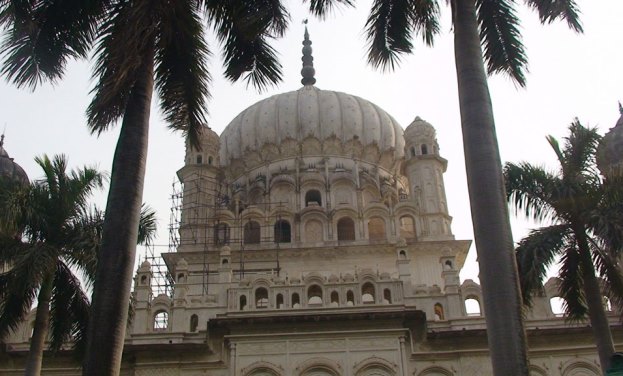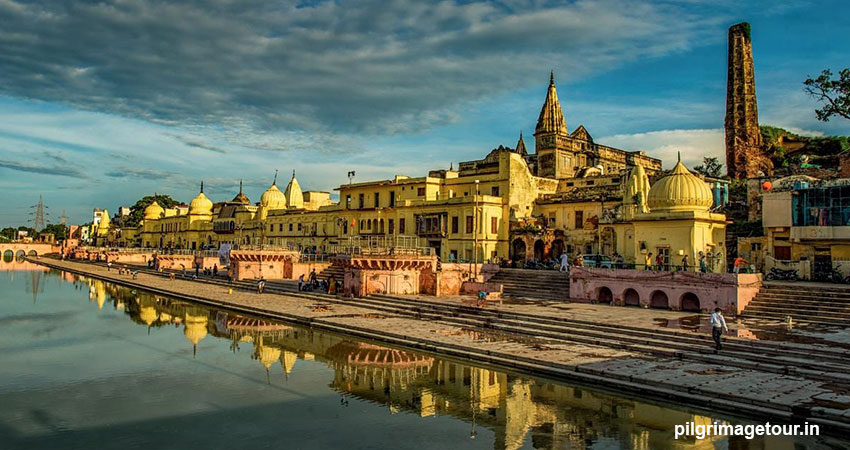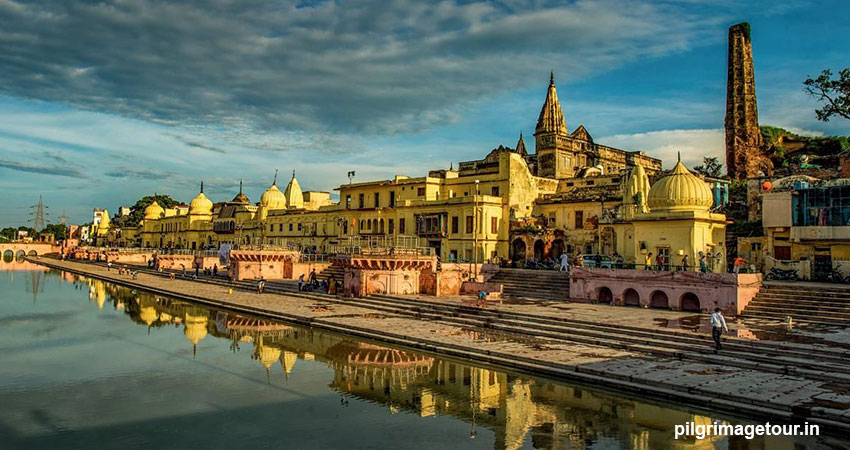Ayodhya, on the banks of the Sarayu River in Uttar Pradesh, is one of Hinduism's seven holiest towns. Ayodhya is an important location in the Hindu epic Ramayana because it is thought to be the birthplace of Lord Rama. The birthplace of four of Jainism's 24 Tirthankaras (religious gurus), this sacred village beckons travellers with its tranquil ghats.
Ayodhya has been surrounded by controversy for over a decade, thanks to its abundance of monkeys, the hum of tourists, and an overall spiritual air. It was the epicenter of the 1992 Indian riots over the Babri Masjid controversy. The mosque, which was supposedly erected on the Ram Janmabhoomi Temple, became a source of conflict for Hindus and Muslims alike. In 2005, a terrorist assault took place near the Ramlalla Temple in Ayodhya.
Despite the controversy, Ayodhya offers tourists a wealth of color and spirituality and has established itself as an important spiritual center. The traffic-free lanes of Ayodhya, the site of multifaith temples, are interesting enough to justify a visit.
History of Ayodhya
The city of Ayodhya is well known as the setting for the Hindu mythical epic Ramayana. Saint Manu, the creator of mankind, is said to have established the city and given it to the Ikshvaku clan to reign. Ayodhya was the capital of Kosala during the time, and was controlled by King Dasaratha, a descendant of Ikshvaku. It's worth noting, however, that historians have interpreted Ayodhya's existence as an urban center with structures and palaces, as described in the Ramayana. However, discoveries near modern-day Ayodhya suggest that it lived in a rudimentary state. As a result, the city of Ayodhya in the Ramayana is thought to be fictitious.
According to local legend, following Lord Rama's ascension to heaven, Ayodhya remained desolate and was subsequently resurrected by King Vikramaditya of Ujjain in 50 BCE. Lord Rama's son Kusa, according to the great Kalidasa's Raghuvamsa, was the one who spearheaded Ayodhya's restoration.
Ayodhya is mentioned in several stories, including the Brahmanda Purana and the Garuda Purana, as one of India's "most sacred and principal towns" and "one of the holiest destinations for Hindus." According to Jain tradition, five Tirthankaras were born at Ayodhya: Rishabhanatha (first), Ajitanatha (second), Abhinandananatha (fourth), Sumatinatha (fifth), and Anantanatha (fourteenth).
Faizabad Airport is the closest airport to Ayodhya, at a distance of 8 kilometers. The closest major airport to Ayodhya is Lucknow (Chaudhary Charan Singh Airport), which is around 130 kilometers away. The airport in Lucknow is well connected to most of India's main cities. To go to Ayodhya from the Lucknow airport, you may take a taxi for around INR 2,000. The Bamrauli Airport in Allahabad, about 166 kilometers distant, is the other major airport near Ayodhya.
How to reach Ayodhya by Rail
Ayodhya is well connected to surrounding railway stations as well as important stations in northern India. The Northern Indian Railway's wide gauge Mughalsarai-Lucknow route passes via Ayodhya Railway Station. The Lucknow Express, Varanasi Doon Express, and Delhi Faizabad Express are all daily trains.
How to reach Ayodhya by Road
Ayodhya is linked to all other big cities in Uttar Pradesh via an excellent road network inside the state. Tourists may order a cab from any of the nearest big cities, including Faizabad (7 km), Allahabad (166 km), Lucknow (134 km), and Varanasi (134 km) (209 km).
Ramjanam Bhoomi
 The Ram Janmabhoomi, which translates to "Lord Ram's Birthplace," is said to be the Hindu god Lord Ram's birthplace. Ram, Lord Vishnu's seventh appearance, is claimed to have grown up near the Sarayu River in Ayodhya, according to the Indian epic Ramayan. For Hindu followers, the Ram Janmabhoomi is a sacred location.
The Supreme Court of India gave the Ram Janmabhoomi property to a trust to build the Ram Temple after it had been a contentious lo...
The Ram Janmabhoomi, which translates to "Lord Ram's Birthplace," is said to be the Hindu god Lord Ram's birthplace. Ram, Lord Vishnu's seventh appearance, is claimed to have grown up near the Sarayu River in Ayodhya, according to the Indian epic Ramayan. For Hindu followers, the Ram Janmabhoomi is a sacred location.
The Supreme Court of India gave the Ram Janmabhoomi property to a trust to build the Ram Temple after it had been a contentious lo...Hanuman Garhi
 Hanuman Garhi, a 10-century temple devoted to the Hindu God Hanuman, is located near Sai Nagar. It is usual to visit Hanuman Garhi before visiting the Ram Temple in Ayodhya, making it one of the most prominent temples in the city. Lord Hanuman is said to have dwelt at the temple site defending Ayodhya.
The hilltop temple's entrance is reached through a 76-staircase path. A 6-inch-tall Hanuman statue is housed inside the panoramic vista of the su...
Hanuman Garhi, a 10-century temple devoted to the Hindu God Hanuman, is located near Sai Nagar. It is usual to visit Hanuman Garhi before visiting the Ram Temple in Ayodhya, making it one of the most prominent temples in the city. Lord Hanuman is said to have dwelt at the temple site defending Ayodhya.
The hilltop temple's entrance is reached through a 76-staircase path. A 6-inch-tall Hanuman statue is housed inside the panoramic vista of the su...Bahu Begum Ka Maqbara
 Bahu Begum ka Makbara is a commonly known as the "Taj Mahal of the East" and is located on the Maqbara Road in the town of Faizabad. The non-Mughal architectural magnificence of the Queen Bride Begum Unmatuzzohra Bano, wife and queen of Nawab Shuja- ud- Daula, is reflected in the tomb dedicated to her. It is the highest monument in Faizabad.
The Bahu Begum ka Makbara is a superb example of Awadhi architecture, with three domes, delicately constr...
Bahu Begum ka Makbara is a commonly known as the "Taj Mahal of the East" and is located on the Maqbara Road in the town of Faizabad. The non-Mughal architectural magnificence of the Queen Bride Begum Unmatuzzohra Bano, wife and queen of Nawab Shuja- ud- Daula, is reflected in the tomb dedicated to her. It is the highest monument in Faizabad.
The Bahu Begum ka Makbara is a superb example of Awadhi architecture, with three domes, delicately constr...Tulsi Smarak Bhawan Museum
 The Tulsi Smarak Bhawan was built in commemoration of 16th-century saint-poet Goswami Tulsidas and is said to be the location where Tulsidas wrote the Ramcharita. The Smarak was established in 1969 by Sri Vishwanath Das, the Governor of Uttar Pradesh at the time. It is located on the eastern terminus of the National Highway near Rajgang Crossing in Ayodhya.
The Smarak also has a research center known as the ‘Ayodhya Research Sansthan,' whi...
The Tulsi Smarak Bhawan was built in commemoration of 16th-century saint-poet Goswami Tulsidas and is said to be the location where Tulsidas wrote the Ramcharita. The Smarak was established in 1969 by Sri Vishwanath Das, the Governor of Uttar Pradesh at the time. It is located on the eastern terminus of the National Highway near Rajgang Crossing in Ayodhya.
The Smarak also has a research center known as the ‘Ayodhya Research Sansthan,' whi...Moti Mahal
 Moti Mahal, is a historical and culturally significant monument in Faizabad. The Moti Mahal is also known as the "Pearl Palace."
Every day, a large number of tourists visit Faizabad's Moti Mahal. Tourists travel from all over the world to visit. Foreigners and Indians alike visit Moti Mahal while in Faizabad. The splendor of the Moti Mahal in Faizabad is acknowledged as the essence of the rich history of the Nawabi culture that thrived in t...
Moti Mahal, is a historical and culturally significant monument in Faizabad. The Moti Mahal is also known as the "Pearl Palace."
Every day, a large number of tourists visit Faizabad's Moti Mahal. Tourists travel from all over the world to visit. Foreigners and Indians alike visit Moti Mahal while in Faizabad. The splendor of the Moti Mahal in Faizabad is acknowledged as the essence of the rich history of the Nawabi culture that thrived in t...Sita Ki Rasoi
 Sita ki Rasoi is an old kitchen said to have been used by goddess Sita herself. It is located on the north-western side of the Ram Janmanhoomi in Ayodhya's Rajkot. This hallowed place, which is near to the Ram Janmabhoomi, is now a temple with several display items. This Sita Ki Rasoi is a subterranean kitchen and one of the two kitchens named after Sita.
The beautifully dressed and adorned idols of Ram, Lakshman, Bharat, and Shatrughan, as well...
Sita ki Rasoi is an old kitchen said to have been used by goddess Sita herself. It is located on the north-western side of the Ram Janmanhoomi in Ayodhya's Rajkot. This hallowed place, which is near to the Ram Janmabhoomi, is now a temple with several display items. This Sita Ki Rasoi is a subterranean kitchen and one of the two kitchens named after Sita.
The beautifully dressed and adorned idols of Ram, Lakshman, Bharat, and Shatrughan, as well...Treta Ke Thakur
 The Treta Ke Thakur Temple, located beside Ayodhya's Naya Ghat, features a number of idols, including those of Lord Ram, Sita, Lakshman, Hanuman, Bharat, and Sugreev. These sculptures are reported to be made of a single piece of black sandstone.
Treta Ke Thakur is thought to have been built 300 years ago by Kullu, the then-king of the region. This temple is claimed to be built on the same spot where Lord Rama performed the legendary Ashwamedha Y...
The Treta Ke Thakur Temple, located beside Ayodhya's Naya Ghat, features a number of idols, including those of Lord Ram, Sita, Lakshman, Hanuman, Bharat, and Sugreev. These sculptures are reported to be made of a single piece of black sandstone.
Treta Ke Thakur is thought to have been built 300 years ago by Kullu, the then-king of the region. This temple is claimed to be built on the same spot where Lord Rama performed the legendary Ashwamedha Y...Nageshwarnath Temple
 The Nageshwarnath Temple, named after the local god Lord Nageshwarnath, is located next to the Theri Bazaar in Ayodhya. It is said to have been founded by Lord Rama's son, Kush or Kusha.
Although this sacred place has been well-maintained since 750 AD, Safar Jung's minister, Naval Rai, is reported to have built the existing temple in 1750. When Kush's arm ring was lost in the local bath, legend has it that he met a Shiva devotee named Naga Kanya...
The Nageshwarnath Temple, named after the local god Lord Nageshwarnath, is located next to the Theri Bazaar in Ayodhya. It is said to have been founded by Lord Rama's son, Kush or Kusha.
Although this sacred place has been well-maintained since 750 AD, Safar Jung's minister, Naval Rai, is reported to have built the existing temple in 1750. When Kush's arm ring was lost in the local bath, legend has it that he met a Shiva devotee named Naga Kanya...Gulab Bari
 The Gulab Bari, also known as the Rose Garden, is located in Vaidehi Nagar. It is the mausoleum of Nawab Shuja-ud-Daula, the third Nawab of Faizabad (Oudh or Awadh), and his parents.
The Gulab Bari's 18th-century edifice has genuine Nawab-styled architecture, as well as a wide variety of rose species, fountains, and beautiful flora. Gulab Bari is presently maintained as part of national heritage, having been listed under the Ancient Monuments an...
The Gulab Bari, also known as the Rose Garden, is located in Vaidehi Nagar. It is the mausoleum of Nawab Shuja-ud-Daula, the third Nawab of Faizabad (Oudh or Awadh), and his parents.
The Gulab Bari's 18th-century edifice has genuine Nawab-styled architecture, as well as a wide variety of rose species, fountains, and beautiful flora. Gulab Bari is presently maintained as part of national heritage, having been listed under the Ancient Monuments an...Kanak Bhawan
 The Kanak Bhawan is located in Tulsi Nagar, near the northeastern part of the Ram Janmabhoomi. This temple, also known as Sone-ka-Ghar, was built in 1891. It is a Hindu pilgrimage place devoted to Lord Rama and his wife, Goddess Sita.
The sanctum santorum of Kanak Bhawan, which also means Golden Palace, has three golden-crowned statues of the two gods under a silver canopy (Garbagriha). This shrine is said to have been given to Rama and Sita by ...
The Kanak Bhawan is located in Tulsi Nagar, near the northeastern part of the Ram Janmabhoomi. This temple, also known as Sone-ka-Ghar, was built in 1891. It is a Hindu pilgrimage place devoted to Lord Rama and his wife, Goddess Sita.
The sanctum santorum of Kanak Bhawan, which also means Golden Palace, has three golden-crowned statues of the two gods under a silver canopy (Garbagriha). This shrine is said to have been given to Rama and Sita by ...Darbarji Durga Kali Temple
 This temple, which is located near Naya Ghat, is linked to various Ramayana stories. Mother Sita, according to legend, came at Ayodhya carrying an icon of goddess Girija Devi following her marriage to Lord Rama. King Dashrath built a lovely temple for the idol, and Mother Sita used to travel there to adore the Devi. Now there is a large statue of Goddess Devkali, the local divinity.
How to reach Darbarji Durga Kali Temple
By AirThe nearest airp...
This temple, which is located near Naya Ghat, is linked to various Ramayana stories. Mother Sita, according to legend, came at Ayodhya carrying an icon of goddess Girija Devi following her marriage to Lord Rama. King Dashrath built a lovely temple for the idol, and Mother Sita used to travel there to adore the Devi. Now there is a large statue of Goddess Devkali, the local divinity.
How to reach Darbarji Durga Kali Temple
By AirThe nearest airp...Jain Shwetamber Temple
 18 ‘Kalyanak' of different ‘tirthankars' have taken place in Ayodhya. Adinath, Ajitnath, Abhinandannath, Sumatinath, and Ananthnath are five Thirthankars who were born and preached their religious principles here. The five Jain temples were built by Kesari Singh, the treasurer of the Nawab of Faizabad, to commemorate the Thirthankers' birthplace. This Digamber Jain temple is dedicated to Rishabhdev, the first Tirthanker, also known as...
18 ‘Kalyanak' of different ‘tirthankars' have taken place in Ayodhya. Adinath, Ajitnath, Abhinandannath, Sumatinath, and Ananthnath are five Thirthankars who were born and preached their religious principles here. The five Jain temples were built by Kesari Singh, the treasurer of the Nawab of Faizabad, to commemorate the Thirthankers' birthplace. This Digamber Jain temple is dedicated to Rishabhdev, the first Tirthanker, also known as...


 +91-7303039611
+91-7303039611